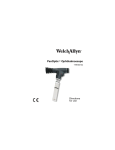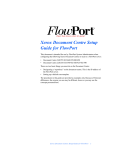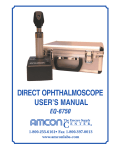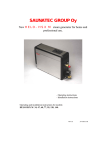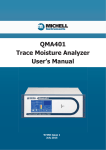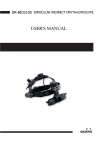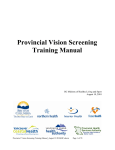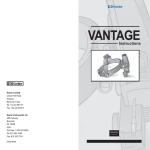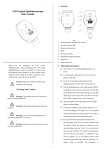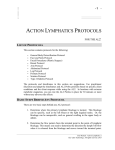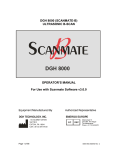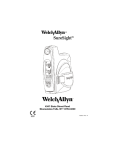Download PanOptic User`s Manual
Transcript
PanOptic™ Ophthalmoscope 118 Series Operating Instruction Manual This product is protected by the following US patents: 6,065,837; 6,390,625; 6,409,341; 6,527,390; U.S. Pub. No. US20020097379; other patents pending. AU App. No. 16331/100; AU App. No. 2001263366; CA App. No. 2,352,148; CA App. No. 2,409,596; PRC App. No. 99813584.4; EP App. No. 99959085.4; EP App. No. 01937653.2; JP App. No. 2000-583418. ©2008 by Welch Allyn, Inc. All rights reserved. No part of this manual may be reproduced or transmitted in any form or by any means, electronic or mechanical, including photocopy, without prior consent in writing from Welch Allyn. Printed in the U.S.A. ii Table of Contents Symbols. . . . . . . . . . . . . . . . . . . . . . . . . . . . . . . . . . . . . . . . 1 Warnings and Cautions . . . . . . . . . . . . . . . . . . . . . . . . . . . 2 The PanOptic™ Ophthalmoscope . . . . . . . . . . . . . . . . 4 Set-up Instructions . . . . . . . . . . . . . . . . . . . . . . . . . . . . . . . 5 Conducting an Examination with the PanOptic Ophthalmoscope. . . . . . . . . . . . . . . . . . . . . . . . . . . . . . . . . 7 Apertures and Filters . . . . . . . . . . . . . . . . . . . . . . . . . . . . 12 The Eye . . . . . . . . . . . . . . . . . . . . . . . . . . . . . . . . . . . . . . . 14 Lamp Replacement Instructions . . . . . . . . . . . . . . . . . . . 15 Cleaning and Repair Instructions. . . . . . . . . . . . . . . . . . . 16 Troubleshooting . . . . . . . . . . . . . . . . . . . . . . . . . . . . . . . . 17 Accessory and Replacement Parts List . . . . . . . . . . . . . . 19 Service and Warranty Information. . . . . . . . . . . . . . . . . . 20 Specifications . . . . . . . . . . . . . . . . . . . . . . . . . . . . . . . . . . 22 iv Symbols Attention. Read Operating Manual for Cautions and Instructions for Use. TYPE BF – Indicates this is a product with Type BF applied parts (the patient eyecup). The CE mark on this product indicates it has been tested to and conforms with the provisions noted within the 93/42/ EEC Medical Device Directive. 1 Warnings and Cautions CAUTION: To minimize lamp housing temperatures, ontime should not exceed 2 minutes with off-time not less than 10 minutes. CAUTION: No acute optical radiation hazards are identified for ophthalmoscopes. However, Welch Allyn recommends limiting the intensity of the light directed into the patient’s eye to the minimum level that is necessary for diagnosis. Infants, aphakes, and persons with diseased eyes are at a greater risk. The risk is also increased if the examined person has had any exposure with the same instrument or any other ophthalmic instrument using a visible light source within the previous 24 hours. This will apply particularly if the eye has had exposure to retinal photography. The intended use of this device is for routine ophthalmic exams on the order of typically less than 60 seconds per eye. Although there is a benefit versus risk factor in any medical procedure, these more complicated exams should not exceed a three minute exam time in 24 hours. Significant use of this device beyond its intended use is not recommended; it may cause harm to the eyes. Use only PanOptic Patient Eyecups (part number 118092) with this product. CAUTION: Federal Law restricts this device to sale by or order of a physician. CAUTION: Spectrally weighted photochemical radiance LB and LA give a measure of the potential hazard that exists for a beam of light to cause photochemical damage to the retina. LB gives the measure for eyes in which a crystalline lens is not in place. LA gives this measure either for eyes in which the crystalline lens has been removed (aphakes) and has not been replaced by a UV-blocking lens or for the eyes of very young children. 2 The value stated for this ophthalmoscope gives a measure of hazard potential when the instrument is operated at maximum intensity and maximum aperture. Values of LB or LA over 684mW/(cm2*sr) are considered high. The retinal exposure dose for a photochemical hazard is a product of the radiance and the exposure time. For instance, at a radiance level of 684mW/(cm2*sr), a 3-minute exposure would produce a retinal exposure dose level at the recommended limit. If the value of radiance were reduced to 342mW/(cm2*sr), twice that time (i.e. 6 minutes) is needed to reach the recommended limit. The recommended exposure dose is based on calculations using the American Conference of Governmental Industrial Hygienists (ACGIH) Threshold Limit Values for Chemical Substances and Physical Agents (1995-1996 Edition). The 118 Series Ophthalmoscope has spectrally weighted photochemical radiances at maximum intensity and maximum aperture of .281 W/(cm2*sr) for LB and .300 W/ (cm2*sr) for LA (aphake). The relative spectral output of the device is shown below. 305 340 375 410 445 480 515 550 585 620 655 690 725 760 W a ve le ngth (nm ) 3 795 830 865 900 935 970 1005 1040 1075 The PanOptic™ Ophthalmoscope Transparency of the cornea, lens and vitreous humor permits the practitioner to directly view arteries, veins, and the optic nerve of the retina. Direct observation of the structures of the fundus through a PanOptic Ophthalmoscope may show disease of the eye itself or may reveal abnormalities indicative of disease elsewhere in the body. Among the most important of these are vascular changes due to diabetes or hypertension and swelling of the optic nerve head due to papilledema or optic neuritis. In this sense, the eye serves as a window through which many valuable clinical evaluations may be made. When a preliminary diagnosis of an imminently dangerous eye condition, such as acute (angle-closure) glaucoma or retinal detachment, is made by the examiner, prompt referral to an eye specialist may prevent irreversible damage. Or, when distressing but less urgent conditions, such as visual impairment due to cataract or vitreous floaters, are recognized, the patient can be reassured and referred. A F B E C D A Patient Eyecup D Aperture/Filter Dial B Patient’s Side E Focusing Wheel C Soft Grip Handle F Practitioner’s Side Brow Rest 4 Set-up Instructions Attaching the PanOptic Ophthalmoscope head to a Welch Allyn Power Source Align cutouts in the PanOptic Ophthalmoscope base with lugs on power source. (The PanOptic Ophthalmoscope fits all 3.5v Welch Allyn power sources.) Push in slightly and turn 90 degrees. TURN HANDLE COUNTERCLOCKWISE Attaching the Patient Eyecup to PanOptic Use only PanOptic Patient Eyecups (part number 118092) with this product. Insert eyecup into the patient’s side of the instrument. Push and twist in one motion until you feel the two “lock” together. See “Accessory and Replacement Parts List” on page 19 to reorder new PanOptic Patient Eyecups. 5 TWIST Attaching Corneal Viewing Lens to PanOptic (Model 11820 only) Insert Corneal Viewing Lens into patient’s side of the instrument. Push and twist in one motion until you feel the two “lock” together as shown on page 5, except replacing Patient Eyecup with the Corneal Viewing Lens. Verify that the line on the lens housing is aligned with the top seam of the PanOptic instrument. 6 Conducting an Examination with the PanOptic Ophthalmoscope 1. To examine the right eye, stand or sit to the patient’s right side. 2. Remove Spectacles (preferred, but not required). 3. Look through the scope (from the doctor’s side) with your thumb on the focusing wheel. Focus the scope on an object roughly 15 feet away. (This procedure will make any adjustments for your own eye’s corrective needs.) 4. Start with the small aperture (green line position on the aperture dial). 7 5. Turn the scope on (using any Welch Allyn 3.5V power source). Adjust light intensity rheostat to desired position. You are now ready to begin the examination: 6. Examiner should be positioned approximately 15 degrees to the temporal side of the patient. 7. Instruct the patient to look straight ahead at a distant object. 8. Begin from about 6 inches away, looking through the scope and shining the light at the patient’s eye while looking for the red retinal reflex. 9. Rest your left hand on the patient’s forehead. (optional) 8 10. Slowly follow the red reflex toward the patient and into the pupil. Get as close as possible for the optimum view (the eyecup should contact the patient’s brow). 11. Once you have a stable view of the fundus rotate the focusing wheel until you have a crisp view of the optic disc and the vessels surrounding it. Note: For the largest view, compress the eyecup halfway against the patient’s brow. This enables the user to view the entire optic disc plus many surrounding vessels (about 25° field of view) at one time. 9 12. Examine the optic disc for clarity of outline, color, elevation and condition of the vessels. Follow each vessel as far to the periphery as you can. To locate the macula, focus on the disc, then move the light approximately one (1) disc diameter temporally. You may also have the patient look at the light of the ophthalmoscope, which will automatically place the macula in full view. Examine for abnormalities in the macular area. The red-free filter facilitates viewing of the center of the macula, or the fovea. 13. To examine the extreme periphery instruct the patient to: A B C D look up for examination of the superior retina look down for examination of the inferior retina look temporally for examination of the temporal retina look nasally for examination of the nasal retina. This routine will reveal almost any abnormality that occurs in the fundus. 10 14. To examine the left eye, repeat the procedure outlined above. However, unlike traditional ophthalmoscopy, a unique feature of PanOptic is that the examiner does not have to switch to his/her left eye. The practitioner can use either eye to examine either patient eye because of the greater working distance between patient and practitioner. This permits those who are strongly dominant in one eye to always use that eye in the fundus exam. 11 Apertures and Filters There is a wide range of practical apertures and filters to select from: small spot, large spot, micro spot, slit aperture, red-free filter, cobalt blue filter (optional), and half-moon aperture (optional). 1. Small Aperture: Provides easy view of the fundus through an undilated pupil. Always start the examination with this aperture and proceed to micro aperture if pupil is particularly small and/or sensitive to light. This position is the “Home” position on the aperture dial and is denoted by the green marking. 2. Large Aperture: Standard aperture for dilated pupil examination of the eye. 3. Micro Spot Aperture: Allows easy entry in very small, undilated pupils. 4. Slit Aperture (Models 11810, 11820 only): Helpful in determining various elevations of lesions, particularly tumors and edematous discs. 5. Red-Free Filter (Model 11810, 11820 only): This filter excludes red rays from the examination field: this is superior to ordinary light in viewing slight alterations in vessels, minute retinal hemorrhages, ill-defined exudates and obscure changes in the macula. The nerve fibers become visible and the observer may note the disappearance of such fibers, as in optic nerve atrophy. The background appears gray, the disc appears white, the macula appears yellow, the fundus reflex is intense and the vessels appear almost black. This filter is also used to help distinguish veins from arteries; veins stay 12 relatively blue, but oxygenated arterial blood makes arteries appear blacker. This greater contrast makes differentiation easier for the examiner. 6. Cobalt Blue Filter (Model 11820 only): In conjunction with fluorescein dye applied topically to the cornea and an add-on magnifying lens (included), this filter is helpful in detecting corneal abrasions and foreign bodies. In this way, it can be used as a surrogate to a Woods Light. 7. Half-Moon Aperture (11810 Only): Provides a combination of depth perception and field-of view. 13 The Eye In addition to examination of the fundus, the PanOptic Ophthalmoscope is a useful diagnostic aid in studying other ocular structures. The light beam can be used to illuminate the cornea and the iris for detecting foreign bodies in the cornea and irregularities of the pupil. The practitioner can also easily detect lens opacities by looking at the pupil through an add-on corneal viewing lens. In the same manner, vitreous opacities can be detected by having the patient look up and down, to the right and to the left. Any vitreous opacities will be seen moving across the pupillary area as the eye changes position or comes back to the primary position. A) Macula B) Vitreous humor C) Sclera D) Choroid E) Retina F) Ora Serrata G) Canal of Schlemm H) Anterior chamber I) Iris J) Cornea K) Ciliary body L) Zonule (Suspensory Ligament) M) Conjunctiva N) Lens O) Hyaloid canal P) Central retinal vein Q) Optic nerve R) Central retinal artery 14 Lamp Replacement Instructions Lamp Replacement Caution: Halogen lamps are pressurized to provide maximum efficiency and illumination. Mistreatment may cause shattering. Protect lamp surface against abrasion and scratches. Verify power is off when replacing lamp. Dispose of lamp with care. CAUTION: Lamps may be hot. Lamp should be allowed to cool before removal. Use only Welch Allyn model 03800 lamp with this product Use your fingernail or a small prying instrument to remove the lamp from the ophthalmoscope head base. ALIGN TAB 15 To insert the new lamp, align tab on lamp with notch in the base of the ophthalmoscope head and push inward until firmly seated. Cleaning and Repair Instructions Cleaning and repairs (with exception of the lamp replacement) beyond what is specified in the “general cleaning instructions” section should be performed at the factory. General Cleaning Instructions NOTE: Excess solution entering the optical assembly could damage internal components. Use caution to ensure cloth is not saturated with solution. This is a precision optical instrument. Please follow these specific cleaning requirements: • Do not use any solvent based cleaners on the lenses. Use only a clean/soft optical grade cleaning cloth on the lenses. • The PanOptic Ophthalmoscope is Non-sterilizable. • Disinfect housing using soft cloth moistened with alcohol. • Clean the Patient Eyecup by any of the following methods: 1. Soft cloth/cotton swab moistened with alcohol. 2. Soaking in gluteraldehyde based solutions (i.e. Cidex OPA). NOTE: For disinfection time / procedure requirements it is recommneded that you follow the directions of the specific brand you are using. 3. • Autoclaving. Do not use acetone based products or other harsh chemicals. No other preventative maintenance is necessary for this product. 16 Troubleshooting Trouble Area Possible Cause Corrective Action Aperture dial is in-between positions Rotate the aperture dial. Lamp burned out. Replace the lamp using Welch Allyn part number 03800. Wrong lamp/ incorrect Welch Allyn lamp/nonWelch Allyn lamp. Replace lamp using Welch Allyn part number 03800. The battery handle has completely discharged. Charge the handle, check the battery, and/or the charger. Spot is not centered. The aperture dial is not centered. Move aperture dial to the full detent position. Not achieving full or expected view. Unit is not in proper operating position. Ensure that the eyecup is slightly compressed during the procedure. No Light output 17 Trouble Area Can not obtain sharp focus/hazy view. Possible Cause Corrective Action The lenses are dirty. Clean the lenses with a clean/soft optical grade cleaning cloth. Lamp pin not engaged in slot. Insert the lamp with pin firmly seated in slot. Film on Optics. Clean the lenses with a clean/soft optical grade cleaning cloth. The handle is not fully charged. Charge the handle, check the battery and/or the charger. Glare in view Fingerprints or dirt on the objective (Patient’s Side) lens. Clean the objective (Patient’s Side) lens with a clean/ soft optical grade cleaning cloth. Cannot attach to power handle. Lamp is not fully inserted. Insert the lamp with pin firmly seated in slot. Dim Light Output 18 Accessory and Replacement Parts List 1 5 3 OR 2 4 Item No. Description Product # 1 Corneal Viewing Lens (model no. 11820 only) 11875 2 Patient Eyecups (Package of five (5) each 118092) 11870 3 Patient’s Side Bumper 118051 4 Lamp 03800 5 Chrome Ring 118027 6 Practitioner’s Side Brow Rest 118052 19 6 Service and Warranty Information Service Centers For information about any Welch Allyn product, call Welch Allyn Customer Support: USA +1 800 535 6663 +1 315 685 4560 Australia +61 2 9638 3000 Canada +1 800 561 8797 China +86 21 6327 9631 European +353 46 90 67790 Call Center France +33 1 60 09 33 66 Germany +49 7477 9271 70 Latin +1 305 669 9003 America Japan +81 3 3219 0071 Netherlands +31 157 505 000 Singapore +65 6419 8100 South +27 11 777 7555 Africa United +44 207 365 6780 Kingdom Sweden +46 85 853 6551 20 PanOptic Ophthalmoscope Warranty Welch Allyn, Inc. warrants the No. 11810, 11820 PanOptic Ophthalmoscope to be free of original defects in material and workmanship and to perform in accordance with manufacturer’s specifications for a period of one year from the date of purchase. If this instrument or any component thereof is found to be defective or at variance with the manufacturer’s specifications during the warranty period, Welch Allyn will repair or replace the instrument or component(s) at no cost to the purchaser. This warranty only applies to instruments purchased new from Welch Allyn or its authorized distributors or representatives. The purchaser must return the instrument directly to Welch Allyn or an authorized distributor or representative and bear the costs of shipping. This warranty does not cover breakage or failure due to tampering, misuse, neglect, accidents, modification or shipping, and is void if the instrument is not used in accordance with manufacturer’s recommendations or if repaired or serviced by other than Welch Allyn or a Welch Allyn authorized representative. No other express or implied warranty is given. 21 Specifications Model Number 11810 PanOptic Ophthalmoscope without Cobalt Blue Filter 11820 PanOptic Ophthalmoscope with Cobalt Blue Filter and Add-on Corneal Viewing Lens Dimensions 5.125”L x 1.4”W x 3.750”H without eyecup Eyecup 1.45”L Weight .48 lbs without eyecup .50 lb with eyecup Approvals EN60601-1 IEC 60601-1-2 CAN/CSA-C22.2 No. 601.1-M90 UL 2601-1, Second Edition, 1997 Equipment Classification IPXØ Equipment not protected against the ingress of water. Equipment not suitable for use in the presence of a flammable anesthetic. Environment Transport/ Storage: -20°C - 49°C, 95% Rh max, 500hPa - 1060 hPa, altitude Operating: 10°C - 49°C, 95% Rh max, 500 hPa - 1060 hPa, altitude CAUTION: Federal Law restricts this device to sale by or order of a physician. 22 Welch Allyn, Inc. 4341 State Street Road Skaneateles, NY 13153-0220 Tel: (800) 535-6663 Printed in U.S.A. Part No. 118088 Rev. F




























